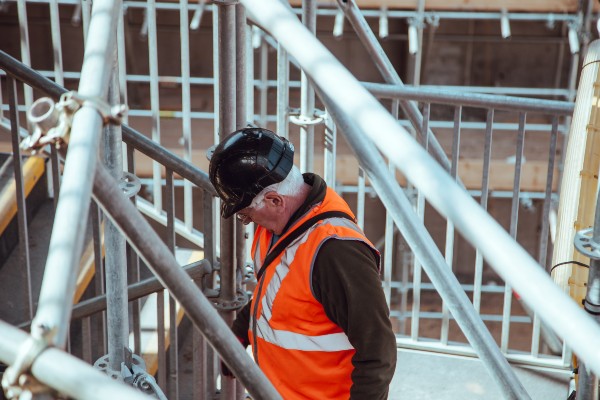Do you know your PPE duties?
On April 6th 2022, the Personal Protective Equipment at Work (Amendment) Regulations 2022 (PPER 2022) comes into force, which will extend employers’ and employees’ duties regarding personal protective equipment (PPE) to ‘limb (b) workers’. But what are ‘limb (b) workers’?
Stuart Dobbins answers the most commonly asked questions surrounding regulation changes and their consequences. He also outlines the best course of action going forwards for businesses.

^ Stuart Dobbins, Technical Claims Manager at Romero Insurance Brokers
What is a ‘limb (b) worker’?
In considering what a ‘limb (b) worker’ might be, we also need to understand what is meant by a ‘limb (a) worker’.
In essence, ‘limb (a)’ describes those workers with a contract of employment.
‘Limb (b)’, however, describes workers who generally have a more casual employment relationship and work under a contract for service – until now their activities have not fallen within the scope of PPE Regulations.
Generally, workers who come under limb (b):
- Carry out casual or irregular work for one or more organisations
- After 1 month of continuous service, receive holiday pay but not other employment rights such as the minimum period of statutory notice
- Only carry out work if they choose to
- Have a contract or other arrangement to do work or services personally for a reward (the contract doesn’t have to be written) and only have a limited right to send someone else to do the work, for example swapping shifts with someone on a pre-approved list (subcontracting)
- Are not in business for themselves (they do not advertise services directly to customers who can then also book their services directly)
What are the new regulations?
As a result of the upcoming changes, the types of duties and responsibilities on employers and employees for the provision and use of PPE will remain unchanged, but these will now extend to ‘limb (b) workers’.
If PPE is required, employers must ensure their workers have sufficient information, instruction and training on the use of PPE. In essence, this means that, if a risk assessment indicates that a ‘limb (b) worker’ requires PPE to carry out their work activities, the employer must carry out a PPE suitability assessment and provide the PPE free of charge as they do for employees.
A ‘limb (b) worker’ will have the duty to use the PPE in accordance with their training and instruction, and ensure it is returned to the storage area provided by their employer.
What is the dichotomy between ‘Limb (b)’ and self-employed?
It should be noted that these changes do not apply to workers who have a ‘self-employed’ status. However, it is not easy to see how some of the descriptions of ‘limb (b) workers’ differ significantly from those that apply to self-employed workers, and therefore there is currently a lack of clarity on how these different individuals should be delineated.
Indeed, the HSE website itself defines ‘limb b’ workers as below:
“A ‘limb (b) worker’ can be understood as a ‘dependent contractor’. A ‘worker’ is registered as self-employed but provides a service as part of someone else’s business. They generally must carry out the work personally, rather than being able to send someone in their place.”
Needless to say this advice is confusing, not least because there appears to be a difference between ‘self-employed’ in practice and someone who has the official status of ‘self-employed’ – i.e. someone who works on a job as part of a ‘gang’ is in practice ‘self-employed’ because he is not an employee of the company who has engaged him. However he is not ‘technically’ self-employed because he does not work solely for himself – he is only able to work under the direction of another employer.
One way to consider the matter is to see the difference as basically the same as that between labour-only and bonafide subcontractors. If someone is under our client’s direction, regardless of whether they are officially ‘employed’ (ie. their mate Stuart Dobbins from the pub) they are still obliged to be provided with PPE. If the person working on site is officially self-employed (as in, S.Dobbins Plumbing and Maintenance) and is not working under our direction then our client would not necessarily be obliged to provide them with PPE. One of the key qualifying definitions on the difference between ‘self-employed’ and ‘limb b’ workers is seen when the HSE says that the latter “are not in business for themselves (they do not advertise services directly to customers who can then also book their services directly)”. As such, the distinction could be described as the ‘Yellow Pages’ test – if the person in question is not in the Yellow Pages as a tradesman then they are probably a ‘limb b’ worker.
Needless to say, more clarification is likely to follow as this new legislation is tested in court. However at present our advice would be that businesses should err on the side of caution to ensure that they continue to adhere to the appropriate regulations and give themselves the best opportunity of defending against any claims that may occur.
– Stuart Dobbins, Technical Claims Manager at Romero Insurance Brokers
More from Stuart Dobbins
Understanding your PPE responsibilities are key for implementation. Businesses who do not deliver appropriate PPE could be placing themselves at risk were an injury and claim to happen.
Contact Romero Insurance Brokers for all questions on your employer-specific PPE obligations. We have an abundance of in-house experts on-hand to answer any of your queries.
Stuart has also spoken on a number of other hot topics recently which could be affecting your business. He has recently authored a whitepaper and also spoken on a podcast about the dangers of being underinsured – as well as commenting upon the Insurance Act.
https://romeroinsurance.co.uk/news/underinsurance-whitepaper/
https://romeroinsurance.co.uk/news/case-study-testing-the-insurance-act/

